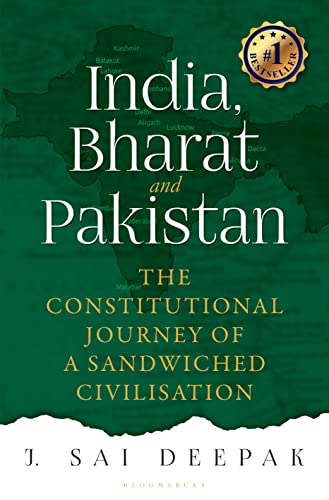India, Bhārat and Pakistan : The Constitutional Journey of a Sandwiched Civilization - Review by Abhishek Desikan
J. Sai Deepak has grown in leaps and bounds as a lawyer, a public speaker, and an inspiration for the youth of India, who are increasingly becoming civilizational aware. Adding to that list is his rise as an author and his second book of the Bhārat trilogy (or is it 4 books now?) - India, Bhārat, and Pakistan is a testament to this.
Continuing from book one, JSD establishes the continuum of Middle Eastern Coloniality in Bhārat after the Mughal empire’s decline. It traces events, personalities, and their impacts, ultimately leading to the Partition of India. The book covers the period starting from 1740 all the way until 1924. It gives a dive deep into history, which is often ignored/under-appreciated when we discuss the freedom movement of India. The seeds of what would eventually become Pakistan were not merely a product of the British divide and rule or the Partition of Bengal in 1905. Rather, they were sown as early as the late 18th century. The book also summarily dismisses the notion of “Ganga-Jamuni tehzeeb,” or Hindu-Muslim unity and syncretic culture, and disillusions one completely.
The book is divided into 3 sections. In section 1, we are given an overview of the different Pan-Islamic movements which started in Bhārat post the decline of the Mughal empire. We are introduced to Shah Waliullah Dehlawi, who inspired various leaders to take up Islamic revivalism, most notably Syed Ahmed Barelvi (Wahhabi movement). While the Wahhabi movement is often portrayed as an Independence movement and a fight against the British, closer analysis reveals how it was a movement to re-establish the religious supremacy of Islam in Bhārat. This is evidenced most notably by their absence in the Mutiny of 1857.
After deeply analyzing the different movements, we are introduced to the architect of the two-nation theory Syed Ahmed Khan. Khan recognized the futility of armed jihad against the British, thus embracing “modernity” and combining it institutionally with Islamic education, and founded Aligarh Muslim University. This allowed Muslims to retain their consciousness while the Hindu elites became a core part of colonial infrastructure while sacrificing their indigenity on all fronts. Khan was also the first to forge a “national” Muslim identity, which had been elusive thus far.
The other important personality in this section is Syed Jamal al-Din al-Afghani. Afghani played a vital role in entrenching the idea of a global ummah and Khilafat, at least two decades before the birth of the Khilafat movement in 1919. This was to reaffirm the concept of a homeland/central authority to which Muslims worldwide would pay allegiance. Thus, Syed Ahmed Khan and Afghani combined to establish Muslim nationalism and pan-Islamism in Bhārat, which led to catastrophic consequences.
Section 2 explores the creation of the Indian National Congress, the events leading to the partition of Bengal in 1905, the “Safety-valve” theory of the British in creating the Indian National Congress, the rise of various revolutionaries and revolutionary movements, and the divisions within the Congress itself as Moderates and Extremists (though fluid in nature). We examine how the British took advantage of pre-existing religious, civilizational, and political divides during the Partition of Bengal.
The partition was a significant moment in India’s history. The events leading to it saw the rise of several revolutionary movements. To keep these movements in check, under the leadership of A.O. Hume, the Indian National Congress was established. The primary goal was to relieve the angst of the populace and give a voice while remaining under British influence, to render the revolutionary movements moot. Soon, two factions emerged in the Congress, the revolutionaries (comprising Lal-Bal-Pal) and the moderates (with Gokhale, Banerjea, etc.). There couldn’t have been a starker difference between the two groups. The Moderates adopted a British loyalist position and only aimed to secure western democracy under the Crown. The Extremists were nationalists in character and demanded complete independence or Purna Swaraj.
This section also details the Muslim league’s formation due to Muslim leaders' fears regarding introducing elective components based on constituencies. We have a detailed analysis of the Minto-Morley reforms and later the Montagu-Chelmsford reforms with primary extracts of the various debates and discussions in the annual meetings of the INC, Muslim League, and the British parliament year after year.
There is also a retrospective of the moderates/extremists thought processes when gathering Muslim support and their respective end goals. However, the need to collaborate with the Muslims only backfired as it kept increasing their demand for concessions, thus compromising Hindu interests at every level.
Finally, section 3 elaborates on the reunification of Bengal, the contribution of Bhārat in the First World War, and the rise of the Khilafat Movement and Gandhi as an influential leader. In particular, the gory details of the Moplah riots make for a spine-chilling read. The book details the riots post the Rowlatt act in Jallianwalla Bagh and the massive destruction caused by Muslims due to the Khilafat stand taken by the British.
We also learn about Gandhi as a staunch British loyalist like the Moderates. He opposed the Home Rule Movement and encouraged passive resistance and Hindus to actively participate and contribute to the Khilafat movement. While the Khilafatists were ready to embrace jihad to secure their goals and use Swaraj to hurt the British, Gandhi did not call for complete independence and even limited means of non-violent methods. His decisions and actions lay waste to his being a “Mahatma.” Ironically, Jinnah was proved right when he openly challenged Gandhi’s idea of non-violent means of resistance, claiming that no independence can be achieved without bloodshed.
In conclusion, the author makes it abundantly clear that this period witnessed the rise of Middle Eastern Coloniality combined with European Coloniality. Bhārat was severely limited in dealing with it due to its dual consciousness. Thus, any reading or interpretation of the independent Bhārat’s constitution must consider this history.

Also published here.